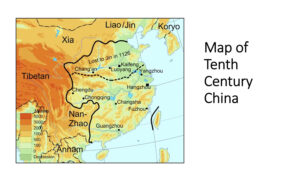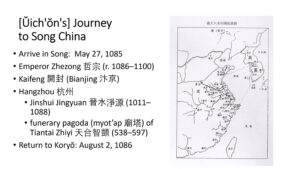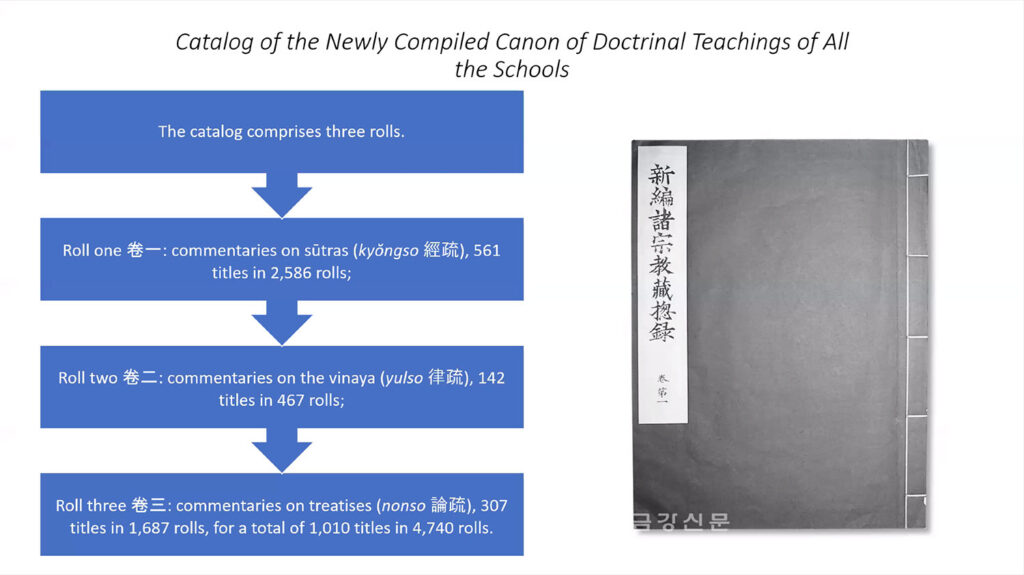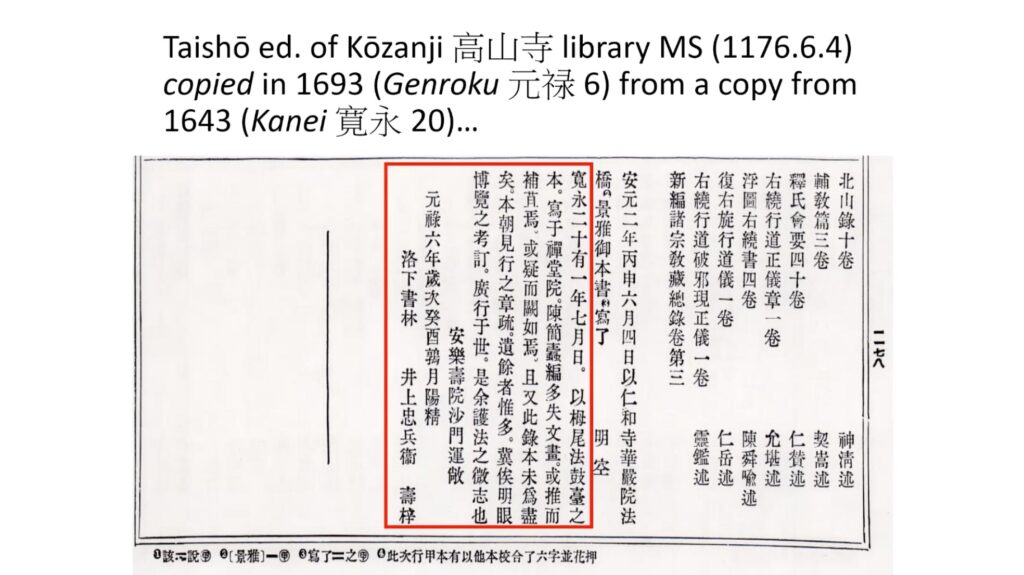By Yipaer Aierken, Arizona State University
On August 3, 2021 a workshop entitled “Buddhist Printing in the Hangzhou Region” was held through Zoom, hosted by Professor Jiang Wu of the University of Arizona and Professor George Keyworth of the University of Saskatchewan. The From the Ground Up: Buddhism and East Asian Religions (Frogbear) Project of the University of British Columbia sponsored this workshop as part of their Summer 2021 Training Program.[1]
 Jiang Wu (University of Arizona) and George Keyworth (University of Saskatchewan). Screenshots courtesy of Carol Lee (UBC Frogbear). Republished with permission.
Jiang Wu (University of Arizona) and George Keyworth (University of Saskatchewan). Screenshots courtesy of Carol Lee (UBC Frogbear). Republished with permission.
At the opening session of the workshop, Professors Wu and Keyworth introduced their research areas and current projects. Professor Wu started with an agenda containing the workshop schedule and training tasks for students in breakout rooms. After a brief introduction of the workshop and a general overview of the methodology, Professor Wu started the workshop by recounting the story of his first interaction with printing blocks, when he identified a Japanese book which was printed from a specific woodblock. In the summer of 2002, these two woodblocks carved with characters were presented to Professor Wu for identification. He recognized them as printing blocks for a Japanese book that is preserved at Harvard-Yenching Library at Harvard University titled, Shikyōgi shitchū hanjidan 四教儀集註半字談 (The Commentary of the Fourfold Teachings and the Half-Word Chat), a sub-commentary of Mengrun’s 蒙潤 (1275–1342) commentary on the Korean monk Chegwan’s 諦観 (d.971?) work Cheotaesagyoui 天台四教儀 (Outline of the Tiantai Fourfold Teachings).
Professor Wu then discussed some key issues in analyzing the history of books and printing. He first expanded on the different methodological approaches to studying books: the history of books from the perspective of cultural and social history; the history of printing as it relates to the history of science and technology; the role of books and printing as agents of change; and the origins and scope of influence of Chinese printing. All of these methodological approaches reflect a particular locus of study, whether it be book history or the printing industry. They also provide careful consideration to the various factors in East Asian societies that revolutionized printing technology. For Chinese books, in particular, the writing materials on which Buddhist scriptures were produced often included bamboo, silk, and paper, and were bound as scrolls, accordion folding style, or string bound. In China, the circulation and readership of printed books involved the government, as well as religious and secular entities that were creating materials to be read by educated elites and government officials, as well as literate common people. For studying a printed book or a block, Professor Wu explained that the first points of interest are the format, layout, font, colophons, frontispieces, illustrations, and technical traces. Lastly, Professor Wu advised that when studying blocks and printing materials, attention should be paid to the production process, the identities of the producers and creators, and the methods of circulation and reproduction that were employed.
They then briefly went over the importance of Hangzhou as a region using two maps. The first map was of tenth-century China and Dr. Wu highlighted the various cultures that surrounded the region. Keyworth then elaborated on the second map from the Song dynasty which showed Ŭich’ŏn 義天 (1055–1101)’s journey into China and illustrated Hangzhou’s broader relation to East Asia, especially Korea as Hangzhou had a huge presence of Korean residents. This journey map shows that by the eleventh century, Hangzhou was clearly a major center where many important teachers lived and was easily accessed by sea.


Left: map of tenth-century China. Right: map of Ŭich’ŏn’s journey in Song dynasty China. Slides courtesy of Jiang Wu. Republished with permission.
Professor Wu continued his presentation by showing the layout and fundamental structure of woodblock prints, as well as the history of printed canons, after providing a basic historical and technical foundation. He explained that the center of the page is where the most information about the book is given. For example, you can see that between the “fish tails” is a space where the title would typically be written. If only one page survived, he explained, the middle of the page would be the most essential because it provides information to identify the text as a whole. He then showed a variety of print examples from different time periods to exemplify how the layout of printing blocks changed slightly over time and where to identify certain elements.
Following the conclusion of part one of the workshop, students were divided into small groups of four to practice identifying the basic characteristics of a printed page and then presented their results. Group one presented Liu Xiang baojuan 劉香寶卷 (The Precious Scroll of Liu Xiang) (1898), produced by the Manao printing house in Suzhou; group two discussed Zhixu’s 智旭 (1599-1655) Yuezang zhijin 閱藏知津 (Guide for Reading the Canon); and group three and group four added details to the previous discussions. In the end, each group presented their results to Professors Wu and Keyworth, and all groups’ members had a lively discussion about these examples including Yuezang zhi jin 閱藏知津 (Guide for Reading the Canon) and Yun’an Zhengjing chan shi yulu 雲菴真浄禪師語錄 (Recorded Sayings of Chan Master Zhenjing of Yun-an).
Professor Wu began the workshop’s second session by introducing the textual lineage of the Taishō Canon (Taishō Shinshū Daizōkyō 大正新修大藏經) While the copied content of the canon is inherently the same, editions of the canon have varied printing characteristics depending on their region and time period. Professor Wu also spoke about the printed edition terms, binding style, and paper quality, and demonstrated the methods for carving blocks through a series of photos. Participants also learned about the Thousand Character Essay (Qianzi wen 千字文), which was a primer for school children to learn Chinese characters created by Zhou Xingsi 周與嗣 (469?–521) in the sixth century. This essay contained one thousand different characters with no repetitions and was required to be memorized by all Chinese students. This essay was later utilized as a method for organizing the canon through a call number system based on the individual characters of the essay.
Professor Keyworth began the second half of Section Two with a history of prints brought to and from Hangzhou by Ŭich’ŏn. He was a Korean Buddhist monk who traveled to Northern Song China in the eleventh century. Ŭich’ŏn visited the Huiyin Gaoli 慧因高麗寺 temple in Hangzhou and collected many doctrinal teachings (kyojang 敎藏) from eminent Huayan 華嚴 teachers. He was also the first to create a catalogue of these East Asian Commentaries which were added to the Korean Buddhist Canon. Ŭich’ŏn arrived in Song on May 27, 1085 during the time of Emperor Zhezong 哲宗 (r. 1086–1100) and returned to Koryŏ on August 2, 1086. During his travels, Ŭich’ŏn visited the Kaifeng (Bianjing 汴京) and Hangzhou regions.
Ŭich’ŏn went to Hangzhou because its libraries were among the best in China in the eleventh century. At the age of twenty-three, he began lecturing on the Avatamsaka-sutra in forty scrolls (T no. 293), as well as Chengguan’s 澄觀 (ca. 738–839) Huayan shu 華嚴疏 (Commentary on the Huayan Sūtra) (X no. 227). He had intended to study with China’s most notable Huayan scholars by examining works by Changshui Zixuan 長水子璿 (965–1038) and Jinshui Jingyuan 晉水淨源 (1011–1088). He also wanted to gather any essays, commentaries, and other teaching materials that he could discover apart from the Taishō Canon. Ŭich’ŏn spent twenty years searching and collecting materials which he later assembled in his Catalog of the Newly Compiled Canon of Doctrinal Teachings of All the Schools (Sinp’yon chejong kyojang ch’ongnok 新編諸宗教藏總錄, T no. 2184), and eventually published the complete canon. Professor Keyworth offered another case study of Taishō edition of the kyojang catalogued in the library of Kōzanji 高山寺 (MS 1176.6.4) that was copied in 1693 from an earlier 1643 copy. Almost unique to Japanese Buddhist manuscript is the fact that in the colophon of the copies, the producer will carefully indicate the origin of the version it is copied from, giving a sense of the textual history of the copy.
 Breakdown of the Catalog of the Newly Compiled Canon of Doctrinal Teachings of All the Schools. Slide courtesy of George Keyworth. Republished with permission.
Breakdown of the Catalog of the Newly Compiled Canon of Doctrinal Teachings of All the Schools. Slide courtesy of George Keyworth. Republished with permission.
 Taishō edition of the Kōzanji 高山寺 library manuscript (MS 1176.6.4). Slide courtesy of George Keyworth. Republished with permission.
Taishō edition of the Kōzanji 高山寺 library manuscript (MS 1176.6.4). Slide courtesy of George Keyworth. Republished with permission.
Professor Wu then moved onto discussions on the Jiaxing Canon (Jiaxing zang 嘉與藏) of the Song and Yuan periods as examples of canon reprints. The Yuanjue Canon (Yuanjue zang 圓覺藏) (Zifu Canon Zifu zang 資福藏 or Sixi Canon Sixi zang 思溪藏, or Huzhou Canon Huzhou zang 湖州藏, or the Zhe edition zheben 浙本) was later divided into two versions because of the changing of the monastery’s name over time: it was first named the Yuanjue Canon and was later renamed Zifu Canon or Later Sixi Canon (Hou Sizi zang 後思溪藏). Starting in 1126 and ending in 1138, this project was carried out at Yuanjue Monastery in Sixi, the Huzou Province (now Zhejiang), under the sponsorship of Wang Yongcong 王永從 and his clan. This edition’s content corresponded to the Chongning Canon (Chongning zang 崇寧藏). Its format was established as thirty columns per sheet, folded in five or six half-pages with five columns per page, and seventeen characters per column, and was preserved in following versions of the canon. At the end of each fascicle, phonetic explanations were given. There are 1419 titles in all, with 5913 fascicles in 548 cases.
Between 1216 and 1322, the Qisha Canon (Qisha zang 磧砂藏) was produced at Qisha Yansheng Monastery 磧砂延聖院 in Pingjiang Prefecture 平江府. The project was started by an official, Zhao Anguo 趙安國, and the monastery’s abbot, Fayin 法音. Its early blocks, carved during the Song dynasty, conformed to the Yuanjue Canon, whereas those carved during the Yuan dynasty were based on the Puning Canon (Puning zang 普寧藏). The whole Qisha Canon consists of 1518 titles and 6363 fascicles in 592 cases. Throughout the Yuan and Ming dynasties, this version was supplemented numerous times. It is formatted in the sutra-binding style, with thirty columns per sheet, folded in five half-pages, with six columns on each half-page, and seventeen characters per column. The first manuscripts thought to be copies of the Wulin Canon (Wulin zang 武林藏) were later identified as printings of the Qisha Canon. It was reprinted in 1935 after a nearly identical copy was discovered in Shanxi, China in 1931.
The Jiaxing Canon (Jiaxing zang 嘉與藏), also known as the Jingshan Canon (Jingshan zang 徑山藏), was produced between 1589 and 1712 and was named after the Jiaxing region’s Lengyan Monastery 嘉興楞嚴寺, which served as the printing and distribution center. The Jiaxing Canon is known as the Jingshan Canon because most of its woodblocks originated from a monastery in Jingshan, and it was additionally known as the “booklet edition” (Fangcezang 方冊藏), referring to the traditional string-bound format in which it was produced. The project began at the start of the Wanli period as a personal undertaking by Yuan Huang 袁潢 (also known as Yuan Liaofan 袁了凡) (1533–1606) and a group of Buddhist literati. The organization of the project was initially undertaken by Zibo Zhenke 紫柏真可 (1543–1603) and his follower Mizang Daokai 密藏道開 (fl. 1593) at Mount Wutai in the north and was later transferred to a location in the south. This version is composed of the main canon, the supplemental canon, and the additional supplementary canon. The volume of text contained in these documents is unparalleled in Chinese history, with 2,195 titles and 10,332 fascicles. The content of its main canon is derived mainly from the Yongle Northern Canon (Yongle beizang 永樂北藏) with some influences that can be traced from the Yongle Southern Canon (Yongle nanzang 永樂南藏). Each is folded into two half-pages, with ten columns and twenty characters per column on each half-page. In 2009, a new edition of the canon in 377 cases was published in Beijing.
In the last section, Professor Keyworth introduced the Jiaxing Canon prints, and other Buddhist prints exported to Edo Japan. In addition to the reprints of the Jiaxing Canon (ca. 1681) by Ōbaku 黄檗宗, Manpukuji 萬福寺 and Tetsugen Dōkō 鉄眼道光 (1630–1683), there is also a reprint from Daiōji 大雄寺 (Tochigi prefecture 栃木県, north of Tokyo), which came as a supplement to the Jiaxing Canon (Xuzang jing 續藏經) and the Second Supplement (You xuzang jing 又續藏經). Chan (Zen) texts in the Daiōji Sūtra Repository (rinzō) 輪藏 are particularly important in this discussion. These Chan texts are not included elsewhere and have a connection to a book that Donggao 東臯 (Japanese: Tōkō Kōchū/ Shin’etsu, 1639–1695) presented to the abbot Kakumon Kantetsu 廓門貫徹 (d.1730). Professor Keyworth also mentioned that a curious fact about the Jiaxing Canon is that besides the usual Chan texts, this canon also bounds other supplementary materials such as dhāraṇī-sūtras including the Jin’gang cuisui tuoluoni 金剛摧碎陀羅尼 (Adamantine Demolishing Dhāraṇī, T no. 1416, J no. 1001), which is Maitrībhadra’s 慈賢 (fl. tenth century) translation of the Vajravidāraṇa-dhāraṇī, and is not preserved in any other printed canon. Professor Wu then showed us his images of Tetsugen blocks during his research trip to Japan and the process of producing the canon prints in Japan. He also discussed the Huikong 慧空 and Manao 瑪瑙 printing shops in later periods, especially the prints from the Huikong Buddhist print house 慧空經房 at Zhaoqing monastery 昭慶. At the end of this workshop, the two professors gave us some references for further reading on Buddhist printing history.
In summary, this workshop highlights the cross-cultural aspects of printing history from China, Japan, and Korea. Hangzhou was the printing center of China from the time of the Wuyue Kingdom 吴越. Buddhist printing, particularly of the Jiaxing Canon, was well-represented in the Hangzhou region. By introducing the prints brought to and from Hangzhou by Ŭich’ŏn, as well as the Huzhou/Sixi, Puning, Jiaxing, Hangzhou Canons editions, and the Huikong and Manao Buddhist print houses, the two workshop leaders trained all participants to use critical thinking with close readings of the workshop materials to analyze manuscripts. Several breakout rooms were utilized throughout the program allowing workshop participants to work with young scholars and students from different fields and created for a more interactive experience through close engagement with the digital objects from the Harvard Library. By doing so, each group was able to present their discussion to the other workshop participants, and share their questions and comments. The breakout room concept was extremely beneficial to the participants in that it allowed them to focus on a single print and practice their newly learned skills, particularly using the terminology of book printing, binding techniques, and the conditions of book prints to analyze the material. The collaboration between Professors Wu and Keyworth was well-organized and enlightening. Vicky Baker and Carol Lee helped participants with technical issues, and took charge of the operation and scheduling of the workshop. All attendees were respectful of one another and put forth a great deal of effort throughout the workshop.
As an art history graduate student, this workshop taught me about more than Buddhist printing history. It gave me and the other participants hands-on practice in analyzing manuscripts from multiple perspectives. These techniques are beneficial not just for graduate students’ dissertation projects, but also for future careers. Networking with other graduate students from various backgrounds allowed me to learn from them and discuss their research methodologies, as well as to keep up with the latest academic research. My questions about Buddhist printing and printing processes were answered during lively discussions with Professors Wu and Keyworth. Though Buddhist printing is not an area I was familiar with, studying in a friendly and respectful environment helped me engage with the workshop’s subject and materials.
I am also deeply grateful to the University of British Columbia’s Frogbear Project, which organizes various workshops to assist graduate students and other researchers in developing skills in multiple areas to assist in the interdisciplinary study of Buddhism. All learning materials were sent out several days before the start of the workshop so that students could prepare. We experienced no Zoom technical difficulties thanks to the efforts of Vicky Baker and Carol Lee. As the workshop date approached, several reminders were issued. Everything was taken care of and went as planned. I am looking forward to participating in future workshops, lecture series, and conferences hosted by the Frogbear Project.
Yipaer Aierken is a PhD candidate in Art History, supervised by Professor Claudia Brown of the School of Art at the Arizona State University. Her dissertation focuses on the transreligious and transethnic aesthetics of Yuan and Qing ethnic art, including Uyghur, Tibetan, Manchu and Mongol.
[1] I would like to express my gratitude to Professor Jiang Wu and Professor Keyworth for their workshop instruction. All the material in this report is based on the workshop’s content. However, I am entirely responsible for any errors. I would also like to thank the University of British Columbia’s Frogbear Project for allowing me to write this report and share some of my own experiences.
Click here to the original posting







